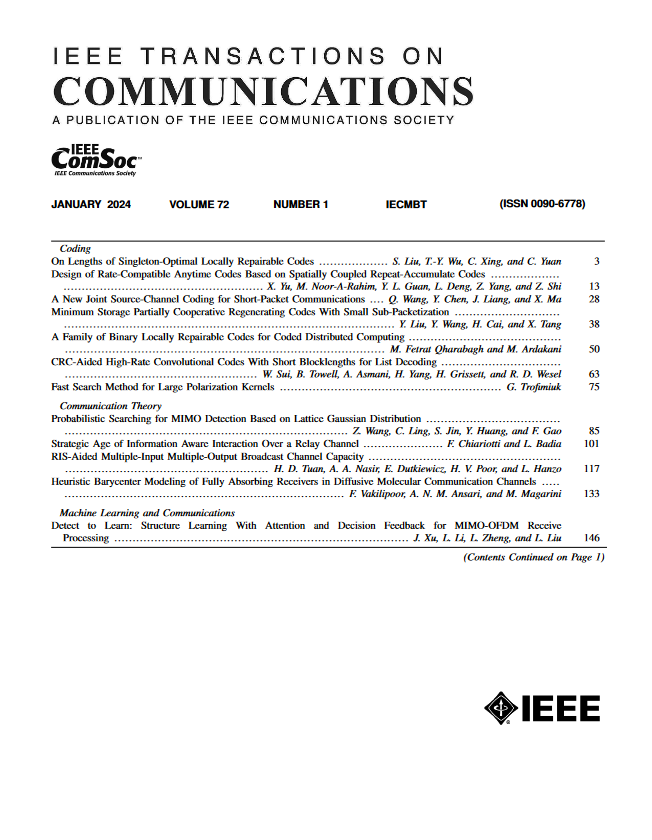Performance Analysis of Multi-RIS-Aided LoRa Systems With Outdated and Imperfect CSI
IF 8.3
2区 计算机科学
Q1 ENGINEERING, ELECTRICAL & ELECTRONIC
引用次数: 0
Abstract
Although LoRa has emerged as the leading technology among the rapidly developing low-power wide-area networks, the performance of the LoRa system severely deteriorates over fading channels. To address this problem, in this paper, we introduce multiple reconfigurable intelligent surfaces (multi-RISs) into the LoRa system to improve its performance. Our specific focus is on the impact of outdated channel state information (CSI), the imperfection of estimated CSI, and the design of RIS discrete phase shifts on the performance. To this end, we first use the moment-matching method to obtain the end-to-end (E2E) channel coefficient of the joint outdated channels and erroneous channels over Nakagami-m fading. Moreover, the closed-form bit error rates (BERs) of the proposed system with non-coherent and coherent detections are derived. The results reveal that, in the high signal-to-noise ratio (SNR) regime, coherent detection encounters the error floor and performs worse than non-coherent detection. Furthermore, we also analyze delay outage rate, throughput, and achievable diversity order of the proposed system. The results show that, despite the presence of outdated CSI and channel estimation errors, the proposed system is still superior to RIS-aided LoRa systems adopting blind transmission and RIS-free ones. Finally, we also thoroughly investigate the effects of various important factors such as the correlation factor, channel estimation errors, the number of RIS reflecting elements, and the number of quantization bits for RIS discrete phase shifts on the performance.基于过时和不完善CSI的多ris辅助LoRa系统性能分析
虽然LoRa已成为快速发展的低功耗广域网的主导技术,但在衰落信道下,LoRa系统的性能严重恶化。为了解决这一问题,本文在LoRa系统中引入了多个可重构智能表面(multi-RISs),以提高其性能。我们的重点是过时的信道状态信息(CSI)的影响,估计CSI的不完善,以及RIS离散相移的设计对性能的影响。为此,我们首先使用矩匹配方法获得了在Nakagami-m衰落下,过时信道和错误信道联合的端到端信道系数。此外,还推导了非相干检测和相干检测下系统的闭式误码率。结果表明,在高信噪比的情况下,相干检测遇到了误差底限,其性能比非相干检测差。此外,我们还分析了系统的延迟中断率、吞吐量和可实现的分集顺序。结果表明,尽管存在过时的CSI和信道估计误差,但该系统仍然优于采用盲传输和无ris的ris辅助LoRa系统。最后,我们还深入研究了相关因子、信道估计误差、RIS反射单元数和RIS离散相移量化比特数等重要因素对性能的影响。
本文章由计算机程序翻译,如有差异,请以英文原文为准。
求助全文
约1分钟内获得全文
求助全文
来源期刊

IEEE Transactions on Communications
工程技术-电信学
CiteScore
16.10
自引率
8.40%
发文量
528
审稿时长
4.1 months
期刊介绍:
The IEEE Transactions on Communications is dedicated to publishing high-quality manuscripts that showcase advancements in the state-of-the-art of telecommunications. Our scope encompasses all aspects of telecommunications, including telephone, telegraphy, facsimile, and television, facilitated by electromagnetic propagation methods such as radio, wire, aerial, underground, coaxial, and submarine cables, as well as waveguides, communication satellites, and lasers. We cover telecommunications in various settings, including marine, aeronautical, space, and fixed station services, addressing topics such as repeaters, radio relaying, signal storage, regeneration, error detection and correction, multiplexing, carrier techniques, communication switching systems, data communications, and communication theory. Join us in advancing the field of telecommunications through groundbreaking research and innovation.
 求助内容:
求助内容: 应助结果提醒方式:
应助结果提醒方式:


